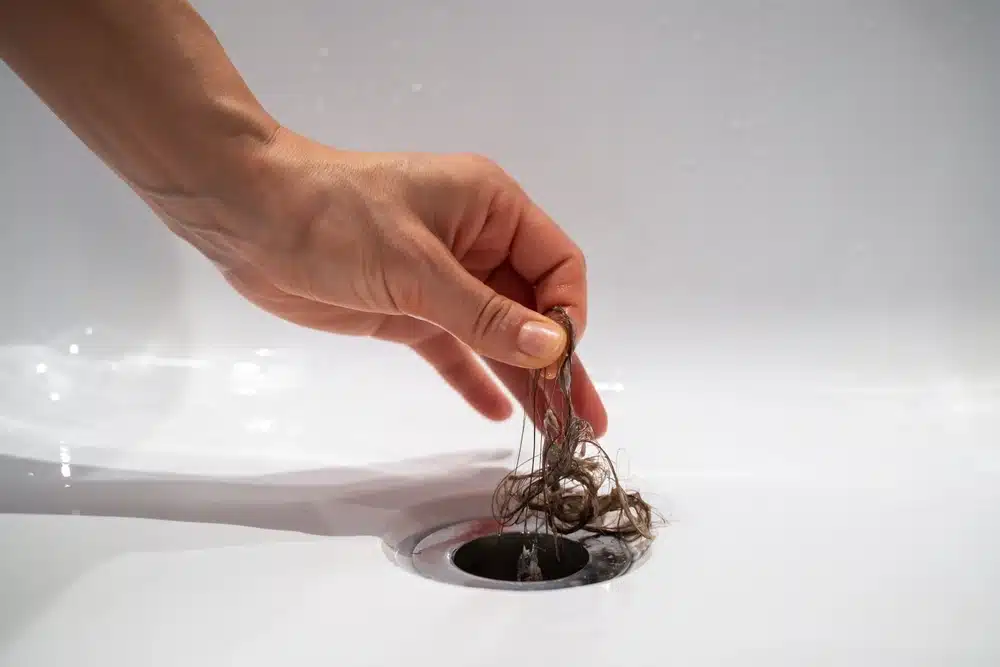The scalp’s surface is home to thousands of hair follicles, each one growing strands of hair. Hair fall occurs, and new regrowth replaces the shed strands – no problem. However, if follicles become damaged or fail to grow new hair, hair loss and a receding hairline can ensue.
A receding hairline is much more common in men – who tend to lose their hair naturally with age. However, it can occur in women, too. Symptoms are usually visible and may develop after the end of puberty or anytime during adulthood.
In men, this recession leads to an “M” shape across the hairline, resulting from gradual hair loss and thinning hair in the front of the scalp closest to the forehead and temples. On the other hand, in women, it can create a “V” shape in the middle of the head – known as a widow’s peak.
Hairline recession is one of the first signs of male pattern baldness (and female pattern baldness) and may stem from various factors ranging from age and hormonal imbalances to lifestyle, medication, stress, and certain health conditions. Whatever the cause, a range of long-term and short-term treatments and ways of managing a receding hairline exist – but what causes a receding hairline, exactly?
What causes a receding hairline?
Losing hair every day is normal; anything between 50 to 100 strands falling from your head daily is considered normal. A receding hairline is also relatively normal, especially in adult males. However, although age is the most common denominator, other issues may lead to hairline recession – some of which are detailed below.
Age
Naturally, age plays a significant role in hair loss; it’s not abnormal for hair to become thinner and hairlines to recede into middle and old age. A receding hairline can also appear in young people as well – as young as late teens to early 20s.
By age 80, around 80% of European men may have a receding hairline, according to research posted on The Journal of Investigative Dermatology.
Family history
Baldness and receding hairlines appear to be hereditary; men with a family history of balding may be more likely to experience the same fate.
Hormonal changes
Hormonal changes can sometimes trigger hair loss in both men and women. In the former, the male sex hormone DHT is a major culprit of male pattern baldness; it causes hair follicles to shrink – so much so that they can no longer grow new strands.
Hormonal imbalances stemming from thyroid problems, as well as menopause and polycystic ovary syndrome in women, may also lead to hair loss and receding hairlines.
Medications and treatments
Certain medications and medical treatments might cause hair loss – such as chemotherapy, which can lead to hair loss that ranges in severity. Other drugs that could lead to hair loss as a side effect include:
- Blood thinners
- Beta-blockers
- Antidepressants
- Certain nonsteroidal anti-inflammatory drugs
- Cholesterol-lowering medicines
- Thyroid medication
- Hormonal contraception (women)
- hormone replacement therapies
- Steroids
Lifestyle
Certain lifestyle factors may lead to hair loss. For example, smokers tend to lose more hair faster than non-smokers. Diet and poor nutrition can also play a part in hair loss and receding hairlines; people who don’t consume enough protein and those lacking in vitamins and minerals usually lose more hair than those who get their recommended nutritional intake.
Additionally, traction alopecia is a lifestyle-related form of hair loss; it results from repeated pulling on the hair, causing trauma to follicles. Tight hairstyles, harsh styling practices, and trichotillomania (a psychiatric compulsive disorder causing patients to pull their hair out repeatedly) may lead to this type of hair loss.
Illness or stress
Some illnesses and heightened levels of stress could induce sudden hair loss – the medical term for which is telogen effluvium. People suffering from this condition may experience an alarming amount of shedding in a short space of time. Fortunately, this type of hair loss is usually reversible.
The receding hairline stages
In the 1950s, James Hamilton created a measurement scale to determine the hairline stages of male pattern hair loss. Later in the 1970s, Dr. O’Tar Norwood improved that scale – now known as the Norwood scale, which defines seven stages of baldness while incorporating specific models of each type of baldness.
Each stage in the scale includes a normal pattern and a class A pattern. The normal pattern typically begins with a bald spot on the top of the head. In contrast, class A balding follows a different progression; instead, the hairline recedes from front to back.
Here’s a rundown of the balding and receding hairline stages before moving on to the treatment stage:
Stage 1
Stage 1 of the Norwood scale for male pattern baldness represents the control stage. Those in stage 1 still have a full head of hair, showing little to no signs of a receding hairline or balding.
Stage 2
The second part in the receding hairline stages is only mild in terms of hair loss – mostly situated around the temples.
Stage 3 (Standard)
Stage 3 is when hair loss becomes more noticeable; the hairline moves backwards from the temples, forming the curved “M” shape from above.
The hairline shape may be less defined in the class A version of the scale (known as stage 3A).
Stage 3 vertex
This stage of balding is a less extreme version of the standard stage 3. Although, people who experience stage 3 vertex balding lose hair on their crown, often appearing as a single small bald spot.
Stage 4
Significant hair loss and hairline recession occur in stage 4. The hairline recedes much further back and may form a “U” shape from above.
The bald spot on the crown also becomes larger; however, a strip of hair still remains between the bald spot and the receded hairline.
In stage 4A, the bald spot on the back of the head isn’t there – but the person loses the dips in the hairline, forming a “U” shape when seen from above.
Stage 5
Hair loss in stage 5 progresses similarly to stage 4 but with greater severity. The small section of hair between the hairline and the balding crown is still present, but it has become much thinner.
In stage 5A, the hairline continues to recede towards the back of the head.
Stage 6
By stage 6, a person is mostly bald on the front and top of the head. These two bald regions connect, and the strip or patch of hair that may have been there previously is now lost.
Hair on the sides of the head may be present, but the front of the head and the crown are bald.
Stage 7
In stage 7, the sides of the head begin to bald until a thin ring of hair circles the outside of the head.
Any hairs that do grow during this final stage are typically very thin and weak.
Treatment for a receding hairline
Sadly, there’s no cure for a receding hairline. However, apart from using wigs and cosmetics to reduce the appearance of hair loss, there are treatment options and ways of managing the problem.
Certain medications can slow a receding hairline down in its tracks while promoting new hair growth, while surgical procedures may also boost hair regrowth and offer a long-term and more permanent solution for balding and hairline recession.
Medication for a receding hairline
Over-the-counter and prescription hair loss medication can be used to slow hair loss and promote growth. Here are some of the options available for managing and treating hair loss and a receding hairline:
- Minoxidil
- Anthralin
- Finasteride or dutasteride
- Corticosteroids
Cosmetic procedures for a receding hairline
As a standalone solution or in combination with medication, cosmetic procedures are also effective in reducing hairline recession and growing new hair. Some options include multiple therapies that work gradually, while others are surgical procedures that provide faster, long-term results.
Among the most common and effective procedures for hair loss and a receding hairline are as follows:
Hair transplant
A hair transplant is a procedure undertaken by a specialist. Donor hair from thicker areas of the head or the body is removed and placed on the front of the head to help fill the receding hairline.
This procedure is a longer-term remedy for a receding hairline and can grant impressive results. Those who decide to explore this option receive a consultation with the transplant specialist beforehand to determine if they are a good candidate for the procedure.
Laster therapy
Laser therapy could boost hair growth in some individuals and reduce male pattern baldness. This procedure involves using a red light (or laser) at a wavelength of 660 nanometers to stimulate hair growth.
Multiple sessions over time may be required, and it could take a while to see results, but most patients are left satisfied.
Receding hairline styles
Whether or not people decide to go down the avenue of medication and procedures, many can reduce the significance of how it looks by choosing the right hairstyle – specifically, receding hairline styles.
Many receding hairline styles and cuts are excellent at hiding, masking, or complementing a receding hairline. Talented hairdressers and barbers can create the perfect look that works with the hairline recession, not against it.
With that in mind, the following haircuts for receding hairlines can work wonders to create a smart, trendy appearance – many of which cleverly incorporates the long top part of the hair to hide or stylishly blend the hair’s thinning and recession.
- Clean shave
- Buzz cut
- Brushed-up quiff
- Slicked back
- Faux hawk
- Taper fade
- Side part
- High fade
- Crew cut
- Butch cut
- Close cut
- Mid fade with spiked hair
- Comb over
- Regulation cut
- Brushed forward hair
Furthermore, longer hairstyles can also work with a receding hairline when styled properly, creating fullness that masks or distracts from the hairline. Another excellent option is a short, messy hairstyle; the stylish, masculine messiness can give the rugged illusion of thicker, fuller hair.
When it comes to choosing a hairstyle, you should take this in several stages. The first course of action is to look over all these options and narrow them down to your top favourites. A high fade might sound good, but you may dislike the look and actually prefer a crew cut upon looking at images. Then, once you have narrowed your options down, talk to your hairdresser about your top styles and what would suit you best. They can offer some top advice on whether a certain style would work for your hair and complete the look for you. Don’t fret if you don’t like the look straight away. It may take some time to get used to, and you can always change it up later on.
Treat Your Hair Loss Today
At Harley Street Hair Clinic, we offer solutions to people suffering from baldness, hair thinning, and receding hairlines every day. If you’d like to discover what our treatments and hair transplant procedures for baldness and hairline recession can do for you, get in touch with our friendly team today.


